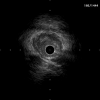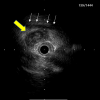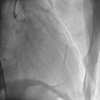Case presentation
The case is a long LAD CTO ( Video 1), characterized by a hint of tapering proximal cap, long occlusion, poorly visualized distal vessel, and poor collateral channel ( Video 2), which was first approached by antegrade wire escalation from Fielder XT-R, Gaia Next1(Asahi Intecc, Japan) over a Caravel 135 cm ( Video 3).
Since the wire tip appeared to be in the vessel of the middle island ( Video 3), the stepdown wire to Sion blue (a workforce wire) successfully entered the distal LAD and a septal branch ( Video 4).
Further wiring by Fielder XT-R did not find any consistent structure of a vessel ( Figure 1), IVUS interrogation was obtained ( Figure 2), which discovered an intimal plaque ( Figure 3).
IVUS was located inside the branch (since the white arrows indicated pericardium), while the vessel north-to-west by a yellow arrow showed apical LAD ( Figure 4). So deflective wiring of Gaia Next 3 led to a successful entry to the target over a dual lumen catheter Sasuke (Asahi Intecc, Japan) ( Video 5).
IVUS confirmed a wire position in the intimal plaque and surrounding hematoma ( Video 6). Following a DEB (Drug Eluting Balloon) dilation ( Figure 5), angiography demonstrated an excellent result down to the LAD apex ( Video 7).
The case illustrated a timely use of IVUS enhances proper orientation of antegrade wiring and results in intimal tracking to the distal end.









